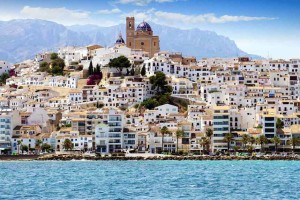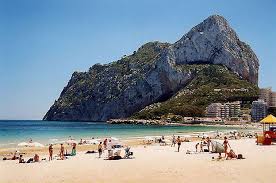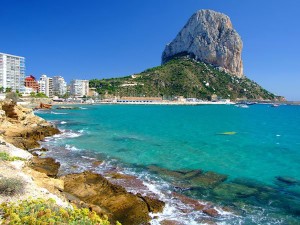Altea is a town and municipality located in the province of Alicante, Spain, north of Alicante on the section of Mediterranean coast called the Costa Blanca. At present, the economy of Altea is based on tourism, which started to grow in the 1950s because of its good weather, beaches and the labyrinthine streets with whitewashed house-fronts that characterize the town. Altea is protected on the north by the bluffs of the Serra de Bèrnia, creating an especially mild microclimate. Its seafront esplanade is planted with palms.
History. The Iberian coastal settlements at the mouth of the Algar river in the wide Bay of Altea were later joined by a Greek marketplace, named Althaia. During the Moorish domination the land around Altea belonged to the Taifa of Dénia until it was recaptured by the Christians in 1244 under James I of Aragon. The town was quickly fortified, and walls were erected to enclose what is now known as the “old town” from outsiders. Main sights. This maze of cobbled narrow and crooked streets with glimpses of the bay is one of the better features of the town. Other sights include the church of La Mare de Déu del Consol (“Our Lady of Solace”), easily identifiable by its picturesque blue and white domes, tiled with glazed ceramics. There are numerous quaint restaurants near the church, some with a view over the Mediterranean. Note that, if visiting by car, you will need to park several blocks away from the church area as the immediately surrounding area is either off limits to cars and/or the streets are so narrow and steep (or have stairs) that cars cannot pass. Puerto Campomanes Marina Greenwich is another main sight you can visit. Located near the cliffs and towards Calpe, it is the biggest port of Altea, the perfect place you can look for all kind of sea activities: from sailing, jetski, daily excursions, canoeing… If you are looking for a good restaurant to taste exquisite food, CLUB NAÚTICO by Gastrogroup is the perfect option offering Modern Fusion Cuisine with a Mediterranean touch plus an outdoor lounge area with beautiful views.
Calp: Calpe is a coastal town located in the comarca of Marina Alta, in the province of Alicante, Valencian Community, Spain, by the Mediterranean Sea. It has an area of 23.5 km² and a population density of 855.45 persons/km². The town is located 67 km from the city of Alicante and lies at the foot of the Natural Park of Penyal d’Ifac. The economy of Calp is based mainly on tourism and fishing. Many Iberian, Roman and Arab archeological sites exist in the town because of its strategic location.
History: There are some remains that testify the presence of inhabitants in the region of Calp in prehistoric times; some remains date back to the Bronze Age. The first buildings were introduced by the Iberians, constructed on the higher grounds. The Penyal d’Ifac (in Spanish Peñón de Ifach) was the natural lookout for the inhabitants that lived in the surrounding areas. Another lookout was the Morro de Toix Mountain, from which the Mascarat Ravine, an essential passage along the coast, could be controlled. The area gained in importance during the Romanization of the Iberian Peninsula. The township’s proximity to the sea favoured marine trade and fish factories. Evidence is at the historical site Els Banys de la Reina (the Queen’s Baths). After the Arabs conquered Iberia, they built a castle overlooking the Mascarat Ravine. When the area was conquered by the Crown of Aragon, the Muslim administration was maintained: small townships set apart and protected by a castle or fortress. Therefore, the inhabitants of the region were dependent upon the Castle of Calp.
In 1290, Calp came under the control of the Aragonese admiral Roger of Lauria, who ordered for a village named Ifach to be built in the proximity of the Rock of Ifach. In 1359, the battle between the then monarch Peter II of Aragon and Peter I of Castile in the War of the Two Peters caused the destruction of Ifac and a surge in the population of the Alqueria (from the Arabic Al-garya, meaning the “small town”). This rural building, generally constructed on mountainsides, is of an austere nature and simple design. It is made up of one or two floors at the most, with just the one gallery.
In 1386, the administrative unit of the Castle of Calp was divided into the towns currently known as Benissa, Teulada, Calp, and Senija. The town was plundered by Barbary pirates in 1687. 290 townsfolk were captured and taken to Algeria, where they were imprisoned for 5 years, until their liberation in exchange for gold and the release of pirate prisoners. Then, the town had 18 houses inside the castle walls and some 350 inhabitants. In the 17th century, there was an increase in the population, which gave rise to the consolidation of Calp. Towards the mid-18th century, several projects arose to build a new fortified wall around the township because by then, the increase in the population forced many inhabitants to live outside the protection of the existing walls. During the 19th century, the village developed towards the west. The basic axis of growth was along the route between Altea and Alicante. During the second half of the 19th century, the fishing industry began to take off throughout the region. Buildings, such as the Fisherman’s Cooperative, were constructed and functioned alongside several existing factories dating from the end of the 18th century. These buildings, however, were not a nucleus of population dedicated to fishing activities. In 1918, the El Saladar salt flats were cleaned up, and the production of salt could once again take place.The Altea and Caple areas are very popular with Ex-pats and Holiday makers and there is always a selection of Spanish Villas, Apartments, Village and Townhouses for Sale in and around these to popular Coastal towns. They are also popular Spanish Holiday areas and there are Villas and Apartments to rent.
| Places of Interest |
Festivals and Holidays |
Eating out the Theatre |
Sightseeing and Tours |
|
|
 |
 |
 |





